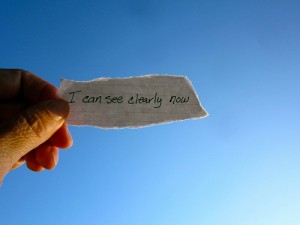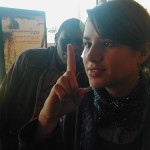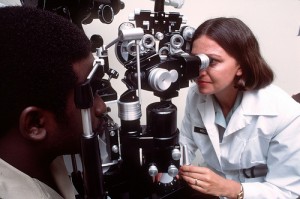by Michelle Sutton-Kerchner
Flatter abs, tighter tush, stronger heart, better mental attitude. These perks are typically associated with exercise. Add another– Improved vision. Let’s clarify …
Recent studies reveal sedentary lifestyles are associated with an increased risk in glaucoma. Low ocular perfusion pressure (OPP) is a risk factor for glaucoma. Cardiovascular fitness gained through moderate physical exercise is proven to reduce this risk.
About Glaucoma

Facts about glaucoma should have you running to the Exercise Floor.
Sometimes called the “silent thief of sight,” it damages vision so slowly it often goes undetected until advanced stages. Once in advanced stages, optic nerve damage already may have limited your vision. Early diagnosis and treatment can minimize, and perhaps prevent, vision loss. There are various types of glaucoma, each with its own symptoms–many that don’t present until it’s too late to prevent.
Risk is increased by factors including age (over 60 years); elevated internal eye pressure; ethnic background (African-, Mexican-, and Asian-Americans are at increased risk); genetic predisposition; health conditions, such as diabetes and hypothyroidism; eye injuries, tumors, or surgeries; nearsightedness (distant objects are unclear); and corticosteroid use.
Glaucoma usually presents when fluid pressure inside the eyes rises and damages the optic nerve. It is one of the leading causes of blindness; however, you can help prevent it. Researchers tracked a study group over a 17-year span, noting their eye pressure and correlating it with their amount of work and leisure physical activity. Moderate physical exercise performed 15 years earlier significantly reduced the risk for developing glaucoma.
 Prior to this study, medication and surgery were considered the only methods for minimizing risk for glaucoma. This recent discovery indicates consistent activity as a preventative measure. Along with reducing risks for other heath issues, a regular fitness routine is now shown to improve long-term eye health.
Prior to this study, medication and surgery were considered the only methods for minimizing risk for glaucoma. This recent discovery indicates consistent activity as a preventative measure. Along with reducing risks for other heath issues, a regular fitness routine is now shown to improve long-term eye health.
Wait! There’s More.
Research proves regular exercise reduces the risk of age-related macular degeneration (AMD) by up to 70 percent. Exercising to fit into skinny jeans seems minor compared to how it can benefit your vision (so you can actually see yourself in those jeans).
Studies show a strong link between physical activity and a reduced risk of AMD. One study followed 4,000 participants, ages 43 to 86, for a 15-year period. One in four led an active lifestyle, defined by working up a sweat a minimum of three times per week.
Those with a physically active lifestyle were 70 percent less likely to develop AMD than their sedentary counterparts. Those who regularly walked more than 12 blocks decreased their risk of AMD by 30 percent.
Exercise reduces inflammation and irregularities found in blood vessel walls associated with the wet form of this disease. It’s also believed by lowering one’s “biological” age, as opposed to calendar age, your body is overall “younger” than those who are sedentary but born the same year. As an age-related disease, AMD may be held off by a body that defies age in this way.
About Age-Related Macular Degeneration
In AMD, light-sensitive cells in the macula, found in the back of the eye, stop working. This degenerative eye disease is the leading cause of vision loss in those over age 60. It is divided into two categories: dry and wet, with the former being more common and able to develop into the latter.
Changes in vision occur gradually, and may affect one or both eyes. If only one eye is affected, you may not notice any symptoms. The good eye compensates. Signs of AMD onset include: an impaired center of vision, blurred fine details, and decreased intensity of colors. In advanced stages, you may have difficulty identifying individuals as faces become obscured when viewing them head-on.
Advanced age seems to be the cause for dry AMD. The macula cells break down with time. Wet AMD develops from the dry version. The macula is in the center of the retina. It’s responsible for clear vision, especially in your direct line of sight.
Risk can be increased if you are genetically predisposed, white, female, obese, smoke cigarettes, have high blood pressure or cholesterol, and lack proper nutrition found in fruits and vegetables.
Clarification through Exercise
Research proves that living a healthy, active lifestyle can reduce the likelihood of eye diseases that lead to vision failure. Maintaining a proper body weight and strong cardiovascular system helps the body’s overall function. It keeps the lid on the pressure system that flows through our entire being, eyeballs included.

Some believe exercises of the actual eyes themselves are beneficial. Without much difficulty, you can find examples like yoga sun gazing, eye squinting and squeezing methods, and other nonconventional techniques for eye health and vision improvement. The results of these methods have not been proven, except for the fact of making silly faces. Don’t throw away your prescription glasses with the hopes of blinking to better vision.
Corrective Laser Surgery
It’s possible to exercise your way to healthier eyes so you can enjoy beautiful vision for years to come. But, what about those annoying contact lenses and everyday four-eyes situations?
General vision problems may be a fact of life. However, for those tired of struggling to see the Group Fitness instructor from the back of the room or popping in contact lenses before diving in the pool, there is a solution. Corrective laser surgery has become increasingly popular. Often, it’s an add-on during cataract removal and other such common procedures. This explains why your grandmother may be better able to see the TV than you.
Candidates include those who have nearsightedness, farsightedness, astigmatism, and presbyopia. Although corrective surgery is an option, physicians recommend noninvasive correctives, such as prescription glasses or contact lenses. As with any surgery, there are risks. Be informed of these and determine if this more serious solution is safe for you. As with any such decision, confirm the benefits outweigh the risks.
Eye Exams

Regular eye exams help detect issues before they cause permanent damage. The American Academy of Ophthalmology recommends:
- comprehensive eye exams every three to five years, starting at age 40, for adults without glaucoma risk factors.
- yearly screenings, beginning at age 60.
- periodic eye exams starting between ages 20 and 39, and every one to two years after age 40, for African-Americans or those with other risk factors for glaucoma.
Each day we learn more on how a healthy lifestyle improves our quality-of-life. It allows us to bypass cholesterol levels that may lead to heart surgery, reduce maintenance meds, and wear the latest slim-cut styles with confidence. We continue to see the benefits, and, with exercise, even more clearly.
Sources
“Exercise May Protect Eye Site,” reviewed by Louise Chang at www.webmd.com.
“Glaucoma” at www.mayoclinic.com.
“Glaucoma Experts Eye Benefits of Exercise,” by Robert Preidt at www.nlm.nih.gov.
“Macular Degeneration,” at www.mayoclinic.com.
Image Credits
Eye (introductory photo): © Janpietruszka at www.dreamstime.com.
Can see clearly: www.flickr.com/photos/katerha/6055323149/
Eye exercises: www.flickr.com/photos/danishta/28274017/
Eye exam: www.flickr.com/photos/expertinfantry/5467594674/
 Fitness & Wellness News Your Source for Fitness News, Wellness News, Health News, and Nutrition News!
Fitness & Wellness News Your Source for Fitness News, Wellness News, Health News, and Nutrition News!



